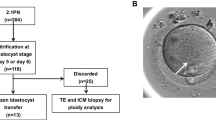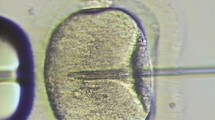Abstract
Purpose
To establish blastocyst freezing criteria for day 7 blastocyst (day 7 BL) for single vitrified-warmed blastocyst transfer (SVBT) by examining the diameter of blastocysts.
Methods
Patients who underwent day 7 BL transfer cycles (1143 cycles, mean age: 38.5 ± 3.5) and randomly selected patients after 1:1 matching who underwent day 6 BL transfer cycles and day 2-single-embryo transfer (SET) cycles were used for analysis. Comparison of the miscarriage (per clinical pregnancy) and live birth rates were made among day 2-SET, day 7 BL, and day 6 BL. These blastocyst groups were stratified into six groups based on blastocyst diameter, namely, 180 μm, 190 μm, 200 μm, 210 μm, over 220 μm, and hatched, for making the freezing criteria.
Results
For each diameter, 180 μm, 190 μm, 200 μm, 210 μm, over 220 μm, and hatched, the live birth rates of day 7 BL after SVBT were 9.0%, 11.9%, 11.5%, 15.6%, 20.0%, and 19.9%, respectively. Compared with the 14.6% live birth rate of the day 2-SET group, the live birth rate of 220 μm day 7 BL was significantly higher (P < 0.05) and was around the same in other diameter groups.
Conclusion
Our study demonstrates that sufficient live birth rates can be obtained after SVBT even from blastocysts on day 7 when blastocysts were vitrified at expanded blastocyst stage of over 180 μm of diameter or at hatched blastocyst stage and were transferred at the optimal time. This is the first study to establish a day 7 blastocyst freezing criteria using blastocyst diameter, which is an objective assessment way.


Similar content being viewed by others
References
Kato K, Takehara Y, Segawa T, Kawachiya S, Okuno T, Kobayashi T, et al. Minimal ovarian stimulation combined with elective single embryo transfer policy: age-specific results of a large, single-center, Japanese cohort. Reprod Biol Endocrinol. 2012;10:35.
Roque M, Valle M, Guimaraes F, Sampaio M, Geber S. Freeze-all policy: fresh vs. frozen-thawed embryo transfer. Fertil Steril. 2015;103:1190–3.
Utsunomiya TIH, Nagaki M, Sato J. A prospective, randomized study: day 3 versus hatching blastocyst stage. Hum Reprod. 2004;19:1598–603.
Du T, Wang Y, Fan Y, Zhang S, Yan Z, Yu W, et al. Fertility and neonatal outcomes of embryos achieving blastulation on day 7: are they of clinical value? Hum Reprod. 2018; 33:1038–51.
Hammond ER, Cree LM, Morbeck DE. Should extended blastocyst culture include day 7? Hum Reprod. 2018;33:991–7.
Steptoe P, Edwards R. Birth after the reimplantation of a human embryo. Lancet. 1978;312:366.
Gardner DKVP, Lane M, Wagley L, Schlenker T, Schoolcraft WB. Culture and transfer of human blastocysts increases implantation rates and reduces the need for multiple embryo transfers. Fertil Steril. 1998;69:84–8.
Kato K, Ueno S, Yabuuchi A, Uchiyama K, Okuno T, Kobayashi T, et al. Women’s age and embryo developmental speed accurately predict clinical pregnancy after single vitrified-warmed blastocyst transfer. Reprod BioMed Online. 2014;29:411–6.
Du QY, Wang EY, Huang Y, Guo XY, Xiong YJ, Yu YP, et al. Blastocoele expansion degree predicts live birth after single blastocyst transfer for fresh and vitrified/warmed single blastocyst transfer cycles. Fertil Steril. 2016;105:910–9 e1.
Almagor M, Harir Y, Fieldust S, Or Y, Shoham Z. Ratio between inner cell mass diameter and blastocyst diameter is correlated with successful pregnancy outcomes of single blastocyst transfers. Fertil Steril. 2016;106:1386–91.
Okimura T, Kuwayama M, Segawa T, Takehara Y, Kato K, Kato O. Relations between the timing of transfer, expansion size and implantation ratesin frozen thawed single blastocyst transfer. Fertil Steril. 2009;92:S246.
Akman M, Garcia J, Damewood M, Watts L, Katz E. Hydrosalpinx affects the implantation of previously cryopreserved embryos. Hum Reprod. 1996;11:1013–4.
Fang C, Huang R, Wei LN, Jia L. Frozen-thawed day 5 blastocyst transfer is associated with a lower risk of ectopic pregnancy than day 3 transfer and fresh transfer. Fertil Steril. 2015;103:655–61 e3.
Johnson N, van Voorst S, Sowter MC, Strandell A, Mol BW. Surgical treatment for tubal disease in women due to undergo in vitro fertilisation. Cochrane Database Syst Rev. 2010:CD002125.
Teramoto SK, O. Minimal ovarian stimulation with clomiphene citrate a large-scale retrospective study. Reprod BioMed Online. 2007;15:134–48.
Mori C, Yabuuchi A, Ezoe K, Murata N, Takayama Y, Okimura T, et al. Hydroxypropyl cellulose as an option for supplementation of cryoprotectant solutions for embryo vitrification in human assisted reproductive technologies. Reprod BioMed Online. 2015;30:613–21.
Hernandez-Nieto C, Lee JA, Slifkin R, Sandler B, Copperman AB, Flisser E. What is the reproductive potential of day 7 euploid embryos? Hum Reprod. 2019;34:1697–706.
Tiegs AW, Sun L, Patounakis G, Scott RT. Worth the wait? Day 7 blastocysts have lower euploidy rates but similar sustained implantation rates as day 5 and day 6 blastocysts. Hum Reprod. 2019;34:1632–9.
Makinen S, Soderstrom-Anttila V, Vainio J, Suikkari AM, Tuuri T. Does long in vitro culture promote large for gestational age babies? Hum Reprod. 2013;28:828–34.
Houghton FDHP, Hawkhead JA, Hall CJ, Leese HJ. Na+, K+, ATPase activity in the human and bovine preimplantation embryo. Dev Biol. 2003;263:360–6.
Montag MKB, Holmes P, Ven H. Significance of the number of embryonic cells and the state of the zona pellucida for hatching of mouse blastocysts in vitro versus in vivo. Biol Reprod. 2000;62:1738–44.
D’Souza F, Pudakalakatti SM, Uppangala S, Honguntikar S, Salian SR, Kalthur G, et al. Unraveling the association between genetic integrity and metabolic activity in pre-implantation stage embryos. Sci Rep. 2016;6:37291.
Sunkara SK, Siozos A, Bolton VN, Khalaf Y, Braude PR, El-Toukhy T. The influence of delayed blastocyst formation on the outcome of frozen-thawed blastocyst transfer: a systematic review and meta-analysis. Hum Reprod. 2010;25:1906–15.
Su Y, Li JJ, Wang C, Haddad G, Wang WH. Aneuploidy analysis in day 7 human blastocysts produced by in vitro fertilization. Reprod Biol Endocrinol. 2016;14:20.
Marcos J, Perez-Albala S, Mifsud A, Molla M, Landeras J, Meseguer M. Collapse of blastocysts is strongly related to lower implantation success: a time-lapse study. Hum Reprod. 20152015; 30: 2501–8.
Author information
Authors and Affiliations
Corresponding author
Ethics declarations
Conflict of interest
The authors declare that they have no conflict of interest.
Ethics approval
This study was reviewed and approved by the independent Institutional Review Board of Kato Ladies Clinic, Tokyo (IRB approval number: 19-30).
Additional information
Publisher’s note
Springer Nature remains neutral with regard to jurisdictional claims in published maps and institutional affiliations.
Rights and permissions
About this article
Cite this article
Ueno, S., Uchiyama, K., Kuroda, T. et al. Establishment of day 7 blastocyst freezing criteria using blastocyst diameter for single vitrified-warmed blastocyst transfer from live birth outcomes: a single-center, large cohort, retrospectively matched study. J Assist Reprod Genet 37, 2327–2335 (2020). https://doi.org/10.1007/s10815-020-01882-8
Received:
Accepted:
Published:
Issue Date:
DOI: https://doi.org/10.1007/s10815-020-01882-8




